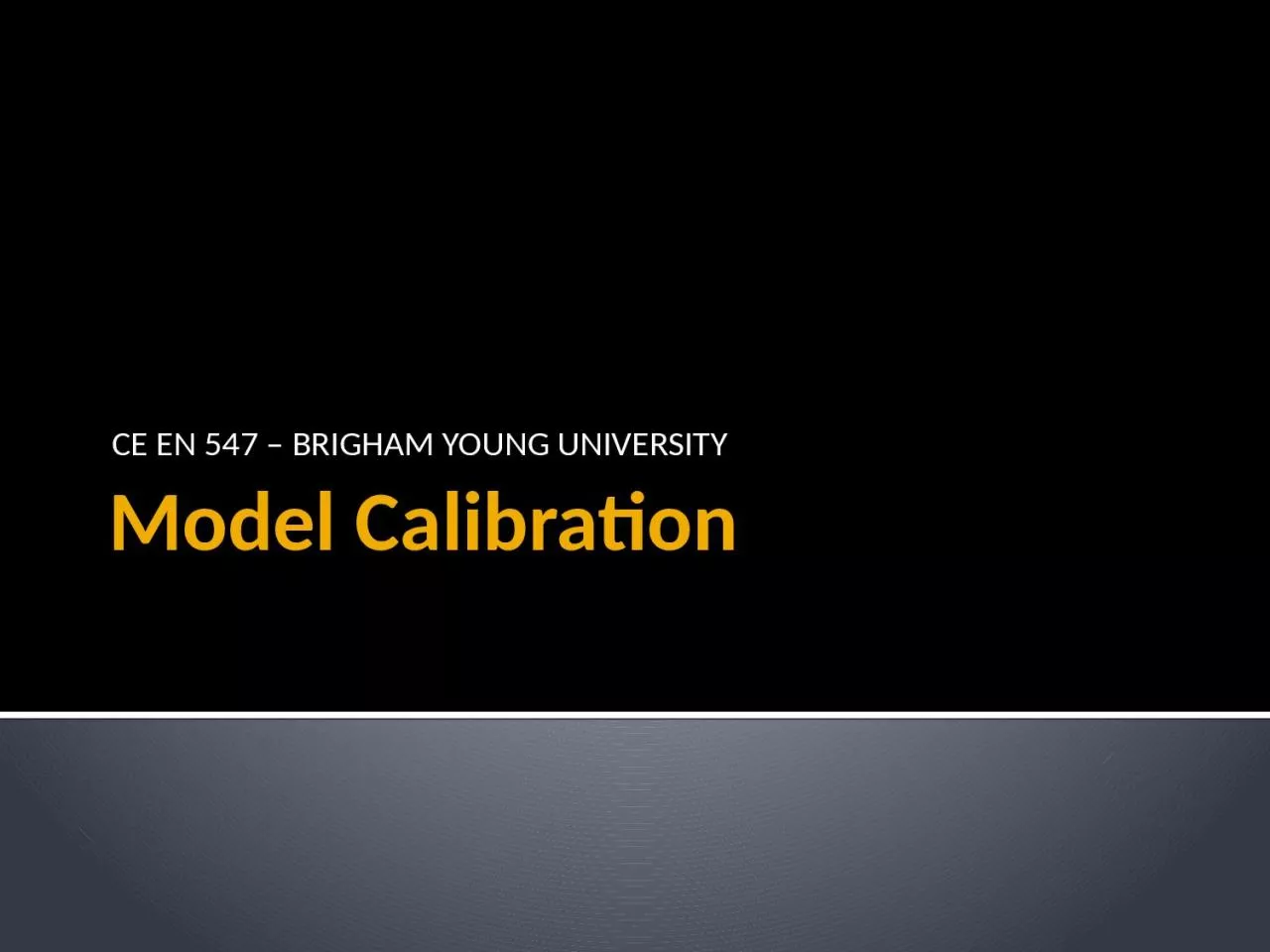

Lecture Objectives Understand the role that calibration plays in the modeling process Be familiar with both manual and automated approaches to model calibration Understand the various error norms used to to quantify calibration ID: 1030774
Download Presentation The PPT/PDF document "Model Calibration CE EN 547 – BRIGHAM ..." is the property of its rightful owner. Permission is granted to download and print the materials on this web site for personal, non-commercial use only, and to display it on your personal computer provided you do not modify the materials and that you retain all copyright notices contained in the materials. By downloading content from our website, you accept the terms of this agreement.
1. Model CalibrationCE EN 547 – BRIGHAM YOUNG UNIVERSITY
2. Lecture ObjectivesUnderstand the role that calibration plays in the modeling processBe familiar with both manual and automated approaches to model calibrationUnderstand the various error norms used to to quantify calibrationUnderstand the concept of model uniqueness
3. CalibrationSolution is computed by modelSimulated heads and flows are compared to field observed valuesInput parameters (K, recharge, etc.) Are adjusted until model outputs match field observations
4. Types of CalibrationTrial and errorManually tweak inputs and re-run modelAutomated parameter estimationOptimization utility is used to adjust input parameters in a systematic fashionPEST, UCODE
5. When is a model “calibrated”?We should not expect a perfect fit between simulated and observed values due to:Measurement errorSimplifying assumptionsUncertainty in inputs (river stages, estimated pumping rates, etc.We generally try to get the simulated values within a certain “window” of the field observations:
6. Calibration Error NormsMean ErrorMean Absolute ErrorRoot Mean Squared ErrorEach error norm provides a numerical measure of how well the model is calibrated
7. Error Norms, cont.where:Weighted errors:Standard deviation can be derived from interval and confidence
8. Error Norms, cont.where:Sum of Squared Weighted Residuals:
9. Calibration in GMSObservation pointsFlow observationsCalibration statisticsAutomated parameter estimation with PEST
10. Observation PointsPrimarily used for head values observed in monitoring wellsPoints are contained in an “Observation Coverage” in the Map module
11. Observation Coverage Setup
12. Observation Point Properties
13. Importing Calibration PointsCan be entered/organized in spreadsheetImport optionsSave to *.txt file and open using Text Import WizardCut and paste directly to Properties dialogRequired. All other columns are optional.
14. Calibration Targets
15. Magnitude of Error
16. Calibration Statistics PlotsClick on Create Plot macroSelect plot type
17. Flow ObservationsRepresentsGain/loss in streamsGain/loss in reservoirs and lakesIf flow observations are not included, the solution may be non-unique+Q-Q
18. Model UniquenessConsider a model of a basin where the only input is recharge. Water leaves system through stream and spec. head boundary. Main parameters are recharge and K.Let’s look at cross section through main axis of site (next slide)
19. Model UniquenessCalibration is achieved by adjusting parameters so that the water table raises or lowers until it fits the head observationsIn order to lower water table:Increase K (water leaves system more rapidly)Reduce Recharge (less water entering system)In order to raise water table:Decrease K (causes water to mound)Increase Recharge (causes water to mound)
20. Model UniquenessLooking at head observations only, calibration can be achieved via:Low K, low rechargeHigh K, high rechargeTheoretically, there are an infinite number of combinations of recharge/K that will “calibrate” the model
21. Model UniquenessIf we include a flow observation for the stream, we eliminate one unknown/degree of freedom from the system since the recharge then becomes fixed.The only remaining unknown is then the hydraulic conductivity (K) and the number of combinations of parameters resulting in “calibration” is drastically reduced
22. ExampleK=0.8R=0.0012Error (SSWR) = 142K=0.2R=0.0003Error (SSWR) = 157In both cases, R is fixed and K is allowed to vary.
23. Example, cont.In this case, we add a flow observation to the river network and solve again for K and RK=0.42R=0.00067Error (SSWR) = 125 (including flow error)
24. Observed FlowsAssigned to arcs and polygons in source/sink coverage
25. Arc GroupsObserved flows may span multiple arcsArc group must be defined so that computed flow is summed correctlyCreate GroupSelect arcsSelect Create Arc GroupAssign FlowSelect with Select Arc Group tool
26. Displaying Computed FlowsSelecting object displays flowMulti-select for total flow
27. Comprehensive Error SummaryRight-click on solution folder in Project Explorer windowSelect Properties